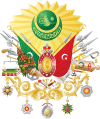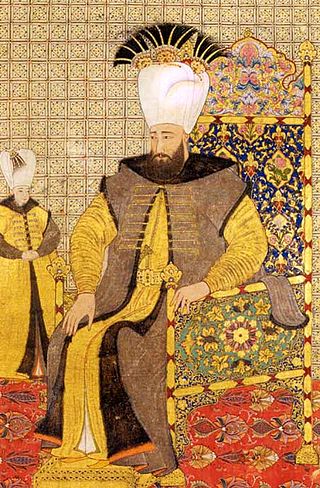
Ahmed III was sultan of the Ottoman Empire and a son of sultan Mehmed IV. His mother was Gülnuş Sultan, originally named Evmania Voria, who was an ethnic Greek. He was born at Hacıoğlu Pazarcık, in Dobruja. He succeeded to the throne in 1703 on the abdication of his brother Mustafa II (1695–1703). Nevşehirli Damat İbrahim Pasha and the Sultan's daughter, Fatma Sultan directed the government from 1718 to 1730, a period referred to as the Tulip Era.

Abdulhamid I or Abdul Hamid I was the 27th sultan of the Ottoman Empire from 1774 to 1789.
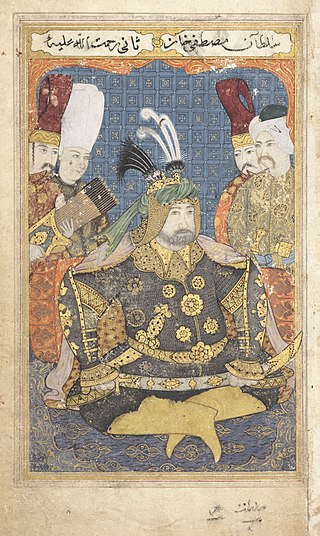
Mustafa II was the sultan of the Ottoman Empire from 1695 to 1703.

Mehmed IV, also known as Mehmed the Hunter, was the sultan of the Ottoman Empire from 1648 to 1687. He came to the throne at the age of six after his father was overthrown in a coup. Mehmed went on to become the second-longest-reigning sultan in Ottoman history after Suleiman the Magnificent. While the initial and final years of his reign were characterized by military defeat and political instability, during his middle years he oversaw the revival of the empire's fortunes associated with the Köprülü era. Mehmed IV was known by contemporaries as a particularly pious ruler, and was referred to as gazi, or "holy warrior" for his role in the many conquests carried out during his long reign.
Mihrişah Sultan, was a consort of Sultan Mustafa III, and the mother of Selim III of the Ottoman Empire, and his Valide sultan for 16 years from 1789 until 1805.
Hatice Sultan was an Ottoman princess, the daughter of Sultan Mustafa III and his consort Adilşah Kadın. She was the half sister of Sultan Selim III.
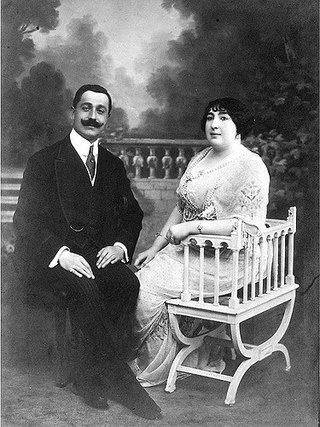
Hamide Ayşe Sultan was an Ottoman princess, the daughter of Sultan Abdul Hamid II and Müşfika Kadın.

Rukiye Sabiha Sultan was an Ottoman princess, the third and last daughter of Sultan Mehmed VI and his first wife Nazikeda Kadın. She was the first wife of Şehzade Ömer Faruk, son of Caliph Abdulmejid II and Şehsuvar Hanım.
Saliha Sultan was an Ottoman princess, the daughter of Sultan Ahmed III, and his consort Hatem Kadın. She had a twin brother who died in infancy, Şehzade Selim. She was the half-sister of Sultans Mustafa III and Abdul Hamid I.

Emine Mihrişah Kadın was a consort of Sultan Ahmed III and the mother of Sultan Mustafa III.
Ayşe Sultan, also called Küçuk Ayşe, was an Ottoman princess, the daughter of Sultan Ahmed III and his consort Muslı Kadın.
Safiye Sultan was an Ottoman princess, daughter of Sultan Mustafa II, and half-sister of Sultans Mahmud I and Osman III of the Ottoman Empire.
Zübeyde Sultan was an Ottoman princess, daughter of Sultan Ahmed III and his consort Musli Kadın. She was the half-sister of Sultans Mustafa III and Abdul Hamid I of the Ottoman Empire.
Şah Sultan was an Ottoman princess, the daughter of Sultan Mustafa III and his consort Rifat Kadın. She was the half sister of Sultan Selim III.
Hatice Sultan was an Ottoman princess, the daughter of Sultan Ahmed III and one of his consorts, Rukiye Kadın.
Emetullah Sultan, called also Ümmetullah Sultan or Heybetullah Sultan, was an Ottoman princess, daughter of Sultan Mustafa II and Şehsuvar Sultan, half-sister of Sultan Mahmud I and full-sister of Sultan Osman III.
Ayşe Athermelik Dürrüşehvar Hanım was the eldest daughter of Sultan Abdul Hamid I of the Ottoman Empire.
Ümmügülsüm Sultan, called also Ümmi Sultan or Gülsüm Sultan, was an Ottoman princess, the daughter of Sultan Mehmed IV, and his Haseki Emetullah Rabia Gülnuş Sultan. She was the sister of Sultans Mustafa II and Ahmed III.
Ayşe Adilşah Kadın was a consort of Ottoman Sultan Mustafa III.
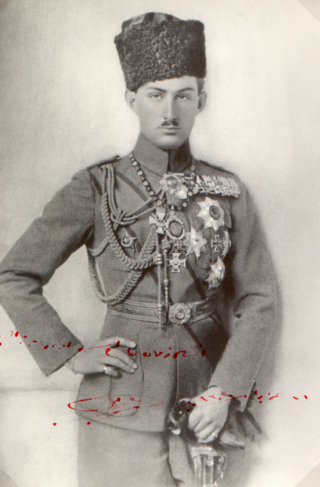
Şehzade Ömer Faruk Efendi was an Ottoman prince, the son of the last caliph of Muslim world Abdulmejid II and his first consort Şehsuvar Hanım. He was also the son-in-law of Sultan Mehmed VI of the Ottoman Empire because he married his younger daughter Rukiye Sabiha Sultan.


















